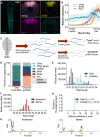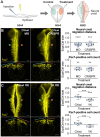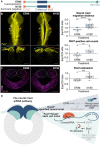Co-option of the piRNA pathway to regulate neural crest specification
- PMID: 35947657
- PMCID: PMC9365273
- DOI: 10.1126/sciadv.abn1441
Co-option of the piRNA pathway to regulate neural crest specification
Abstract
Across Metazoa, Piwi proteins play a critical role in protecting the germline genome through piRNA-mediated repression of transposable elements. In vertebrates, activity of Piwi proteins and the piRNA pathway was thought to be gonad specific. Our results reveal the expression of Piwil1 in a vertebrate somatic cell type, the neural crest. Piwil1 is expressed at low levels throughout the chicken neural tube, peaking in neural crest cells just before the specification event that enables epithelial-to-mesenchymal transition (EMT) and migration into the periphery. Loss of Piwil1 impedes neural crest specification and emigration. Small RNA sequencing reveals somatic piRNAs with sequence signatures of an active ping-pong loop. RNA-seq and functional experiments identify the transposon-derived gene ERNI as Piwil1's target in the neural crest. ERNI, in turn, suppresses Sox2 to precisely control the timing of neural crest specification and EMT. Our data provide mechanistic insight into a novel function of the piRNA pathway as a regulator of somatic development in a vertebrate species.
Figures




Similar articles
-
PIWI-piRNA pathway-mediated transposable element repression in Hydra somatic stem cells.RNA. 2020 May;26(5):550-563. doi: 10.1261/rna.072835.119. Epub 2020 Feb 19. RNA. 2020. PMID: 32075940 Free PMC article.
-
PIWIL1 promotes gastric cancer via a piRNA-independent mechanism.Proc Natl Acad Sci U S A. 2020 Sep 8;117(36):22390-22401. doi: 10.1073/pnas.2008724117. Epub 2020 Aug 26. Proc Natl Acad Sci U S A. 2020. PMID: 32848063 Free PMC article.
-
The Tudor domain protein Tapas, a homolog of the vertebrate Tdrd7, functions in the piRNA pathway to regulate retrotransposons in germline of Drosophila melanogaster.BMC Biol. 2014 Oct 6;12:61. doi: 10.1186/s12915-014-0061-9. BMC Biol. 2014. PMID: 25287931 Free PMC article.
-
PiWi RNA in Neurodevelopment and Neurodegenerative Disorders.Curr Mol Pharmacol. 2022;15(3):517-531. doi: 10.2174/1874467214666210629164535. Curr Mol Pharmacol. 2022. PMID: 34212832 Review.
-
Untangling the web: the diverse functions of the PIWI/piRNA pathway.Mol Reprod Dev. 2013 Aug;80(8):632-64. doi: 10.1002/mrd.22195. Epub 2013 Jun 27. Mol Reprod Dev. 2013. PMID: 23712694 Free PMC article. Review.
Cited by
-
PIWIL1 is recruited to centrosomes during mitosis in colorectal cancer cells and is linked to cell cycle progression.Sci Rep. 2024 Oct 13;14(1):23928. doi: 10.1038/s41598-024-75098-6. Sci Rep. 2024. PMID: 39397093 Free PMC article.
-
Letter to editor regarding "piR-36249 and DHX36 together inhibit testicular cancer cells progression by upregulating OAS2".Noncoding RNA Res. 2023 Aug 18;8(4):589-590. doi: 10.1016/j.ncrna.2023.08.007. eCollection 2023 Dec. Noncoding RNA Res. 2023. PMID: 37662498 Free PMC article.
-
Post-transcriptional regulation as a conserved driver of neural crest and cancer-cell migration.Curr Opin Cell Biol. 2024 Aug;89:102400. doi: 10.1016/j.ceb.2024.102400. Epub 2024 Jul 19. Curr Opin Cell Biol. 2024. PMID: 39032482 Free PMC article. Review.
-
Methylation of lysine 36 on histone H3 is required to control transposon activities in somatic cells.Life Sci Alliance. 2023 May 11;6(8):e202201832. doi: 10.26508/lsa.202201832. Print 2023 Aug. Life Sci Alliance. 2023. PMID: 37169594 Free PMC article.
-
PIWI-Interacting RNAs: A Pivotal Regulator in Neurological Development and Disease.Genes (Basel). 2024 May 21;15(6):653. doi: 10.3390/genes15060653. Genes (Basel). 2024. PMID: 38927589 Free PMC article. Review.
References
-
- Cenik E. S., Zamore P. D., Argonaute proteins. Curr. Biol. 21, R446–R449 (2011). - PubMed
-
- Aravin A. A., Sachidanandam R., Girard A., Fejes-Toth K., Hannon G. J., Developmentally regulated piRNA clusters implicate MILI in transposon control. Science 316, 744–747 (2007). - PubMed
-
- Brennecke J., Aravin A. A., Stark A., Dus M., Kellis M., Sachidanandam R., Hannon G. J., Discrete small RNA-generating loci as master regulators of transposon activity in Drosophila. Cell 128, 1089–1103 (2007). - PubMed
-
- Vagin V. V., Sigova A., Li C., Seitz H., Gvozdev V., Zamore P. D., A distinct small RNA pathway silences selfish genetic elements in the germline. Science 313, 320–324 (2006). - PubMed
-
- Aravin A. A., Hannon G. J., Brennecke J., The Piwi-piRNA pathway provides an adaptive defense in the transposon arms race. Science 318, 761–764 (2007). - PubMed
Grants and funding
LinkOut - more resources
Full Text Sources
Molecular Biology Databases

